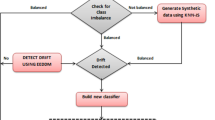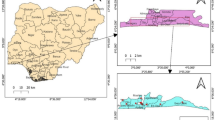Abstract
In ubiquitous stream of data, the issue related to the association rules of fuzzy are considered in this paper, and a new method FFP_USTREAM (Fuzzy Frequent Pattern Ubiquitous Streams) are created. The system of Ubiquitous real-time data incorporates fuzzy ideas with automated streams of data, utilizing the method of sliding window, to mine rules associated for fuzzy logic. The proposed strategy used a matrix of fuzzification where the input patterns related to level of membership to various classes. Attribution of specific classification or class is depending on estimation level of pattern membership. This technique is applied to ten benchmarks data set with classification of learning repository from the UCI machine. The motivation is to evaluate the proposed strategy and, in this manner the performance is compared to a pair of incredible supervised classification algorithms sigmoidal Recurrent Neural Network (RNN) and Adaptive Neuro-fuzzy Inference System (ANFIS). An efficient and complexity of the system are examined. Instances of genuine set of data are utilized to test the proposed system. Existing regression and classification methods is used to compare the proposed fuzzy method. Proposed fuzzy achieves better results when compared to existing method.








Similar content being viewed by others
References
Abdel-Basset M, Mohamed M, Smarandache F, Chang V (2018) Neutrosophic association rule mining algorithm for big data analysis. Symmetry 10(4):106
Chan AH (2018) U.S. Patent No. 10,133,791. Washington: U.S. Patent and Trademark Office
Cunha DSD, Xavier RS, Ferrari DG, Vilasbôas FG, de Castro LN (2018) Bacterial colony algorithms for association rule mining in static and stream data. Math Probl Eng
De Assuncao MD, da Silva Veith A, Buyya R (2018) Distributed data stream processing and edge computing: a survey on resource elasticity and future directions. J Netw Comput Appl 103:1–17
De Silva CW (2018) Intelligent control: fuzzy logic applications. CRC Press, Boca Raton
Deypir M, Sadreddini MH, Hashemi S (2012) Towards a variable size sliding window model for frequent itemset mining over data streams. Comput Ind Eng 63(1):161–172
Dharminder D, Chandran KP (2020) LWESM: learning with error based secure communication in mobile devices using fuzzy extractor. J Ambient Intell Hum Comput. https://doi.org/10.1007/s12652-019-01675-7
Djenouri Y, Belhadi A, Fournier-Viger P (2018) Extracting useful knowledge from event logs: a frequent itemset mining approach. Knowl-Based Syst 139:132–148
Gaber MM, Gama J, Krishnaswamy S, Gomes JB, Stahl F (2014) Data stream mining in ubiquitous environments: state-of-the-art and current directions. Wiley Interdiscip Rev Data Min Knowl Discov 4(2):116–138
Gama J (2013) Data stream mining: the bounded rationality. Informatica 37(1)
Gao Y (2020) The application of artificial neural network in watch modeling design with network community media. J Ambient Intell Human Comput. https://doi.org/10.1007/s12652-020-01689-6
Han J, Cheng H, Xin D, Yan X (2007) Frequent pattern mining: current status and future directions. Data Min Knowl Disc 15(1):55–86
Jian Z, Qingyuan Z, Liying T (2020) Market revenue prediction and error analysis of products based on fuzzy logic and artificial intelligence algorithms. J Ambient Intell Human Comput. https://doi.org/10.1007/s12652-019-01650-2
Kim YH, Kim WY, Kim UM (2010) Mining frequent itemsets with normalized weight in continuous data streams. J Inf Process Syst 6(1):79–90
Krishnamoorthy S, Sadasivam GS, Rajalakshmi M, Kowsalyaa K, Dhivya M (2017) Privacy preserving fuzzy association rule Mining in data clusters using particle swarm optimization. Int J Intell Inf Technol (IJIIT) 13(2):1–20
Langley A, Riddoch A, Wilk A, Vicente A, Krasic C, Zhang D, Bailey J (2017) The quic transport protocol: design and internet-scale deployment. In: Proceedings of the Conference of the ACM Special Interest Group on Data Communication, pp. 183–196
Latif R, Abbas H, Latif S (2016) Distributed denial of service (DDoS) attack detection using data mining approach in cloud-assisted wireless body area networks. Int J Ad Hoc Ubiquitous Comput 23(1–2):24–35
Lee G, Yun U, Ryu KH (2014) Sliding window based weighted maximal frequent pattern mining over data streams. Expert Syst Appl 41(2):694–708
Lin CW, Hong TP, Lu WH (2010) An efficient tree-based fuzzy data mining approach. Int J Fuzzy Syst 12(2):150–157
Madhavan P, Thamizharasi V, Kumar MR, Kumar AS, Jabin MA, Sampathkumar A (2019) Numerical investigation of temperature dependent water infiltrated D-shaped dual core photonic crystal fiber (D-DC-PCF) for sensing applications. Results Phys 13:102289
Melin P, Castillo O (2014) A review on type-2 fuzzy logic applications in clustering, classification and pattern recognition. Appl Soft Comput 21:568–577
Moens S, Aksehirli E, Goethals B (2013) Frequent itemset mining for big data. In IEEE International Conference on Big Data, pp. 111–118
Moustafa A, Abuelnasr B, Abougabal MS (2015) Efficient mining fuzzy association rules from ubiquitous data streams. Alex Eng J 54(2):163–174
Ramírez-Gallego S, Krawczyk B, García S, Woźniak M, Herrera F (2017) A survey on data preprocessing for data stream mining: current status and future directions. Neurocomputing 239:39–57
Saleti S, Subramanyam RBV (2019) A MapReduce solution for incremental mining of sequential patterns from big data. Expert Syst Appl 133:109–125
Sampathkumar A, Vivekanandan P (2018) Gene selection using multiple queen colonies in large scale machine learning. Int J Electr Eng 9(6):97–111
Sampathkumar A, Vivekanandan P (2019) Gene selection using PLOA method in microarray data for cancer classification. J Med Imaging Health Inform 9(6):1294–1300
Solanki SK, Patel JT (2015) A survey on association rule mining. In Fifth International Conference on Advanced Computing & Communication Technologies (pp. 212–216). IEEE
Sukhija K, Jindal M, Aggarwal N (2016) Educational data mining towards knowledge engineering: a review state. Int J Manag Educ 10(1):65–76
Acknowledgements
We acknowledge DST-File No. 368, DST—FIST (SR/FIST/College-235/2014 dated 21 Nov 2014) for financial support and DBT-STAR-College-Scheme-ref.no: BT/HRD/11/09/2018 for providing infrastructure support.
Author information
Authors and Affiliations
Corresponding author
Additional information
Publisher's Note
Springer Nature remains neutral with regard to jurisdictional claims in published maps and institutional affiliations.
Rights and permissions
About this article
Cite this article
Nagaraj, S., Mohanraj, E. A novel fuzzy association rule for efficient data mining of ubiquitous real-time data. J Ambient Intell Human Comput 11, 4753–4763 (2020). https://doi.org/10.1007/s12652-020-01736-2
Received:
Accepted:
Published:
Issue Date:
DOI: https://doi.org/10.1007/s12652-020-01736-2




